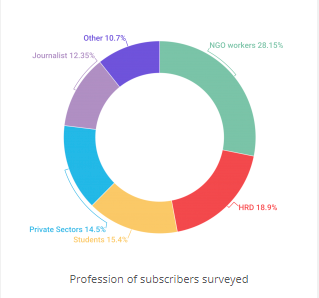Analysis
User Feedback of NepalMonitor.org’s Website
2018-01-24

Since 2012, NepalMonitor.org provides regular updates on security incidents and human rights violations on our website and via email and sms to Human Rights Defenders and subscribers in Nepal. Last year, Nepal Monitor conducted a user survey to find out how people are using our website and alert services and how to improve it in future. Of the total 1568 active sms subscribers at the time, 149 were interviewed over phone and out of 1133 active email subscribers, 39 took part in our online survey. A stratified random sampling was adopted to fix the sample size for the sms subscriber survey.
The survey revealed quite a diverse subscriber base. In the following we summarize some of the findings of the survey regarding the profile of NepalMonitor users:
One third of subscribers were women. Of the 149 sms subscribers interviewed, 48 were female and 101 were male (gender was not asked in the online survey).
Almost one third of people taking part were subscribed for more than one year. 29.2% of respondents who took part in the survey were subscribed to NepalMonitor for more than a year; 40.95% had subscribed for between 3 months and a year and 21.4% for less than three months.
NepalMonitor subscribers came from a range of professions. A plurality of the respondents were NGO workers (28.15%) followed by human right defenders (18.9%), students (15.4%), people working in the private sector (14.5%) and journalists (12.35%).
Most subscribers used NepalMonitor.org to keep themselves up-to-date or for the purpose of research and advocacy. The survey showed that most of the subscribers used the platform to keep themselves updated (72.1%). In addition, 24.5 % of respondents mentioned that they were using the data of NepalMonitor for research purpose and analysis and 10.5 % stated that they used the data for advocacy. (Respondents were allowed to choose more than one option).
Respondents came from districts across Nepal. Respondents in the random sampling came from 42 of Nepal’s 75 districts, demonstrating the wide reach of NepalMonitor’s alert system. However, most responses were recorded from Kathmandu (35), Kailali (16) with Lalitpur and Morang (nine each) and one email response was received from USA via email. For a detailed breakdown of the districts where respondents were based, please see the map.
SMS alerts appreciated in particular by subscribers in rural areas with delayed or limited access to newspapers. SMS subscribers appreciated NepalMonitor.org’s effort for seeking their contribution for the website upgrade. Especially, NGO workers and subscriber from rural areas with limited access to local and national newspaper and internet, have benefited from the sms alert. Journalists and other subscribers were disappointed with NepalMonitor.org’s delivery of information already published in other sources (and at times the delayed delivery of alerts) and suggested to include more exclusive reporting from primary sources.

